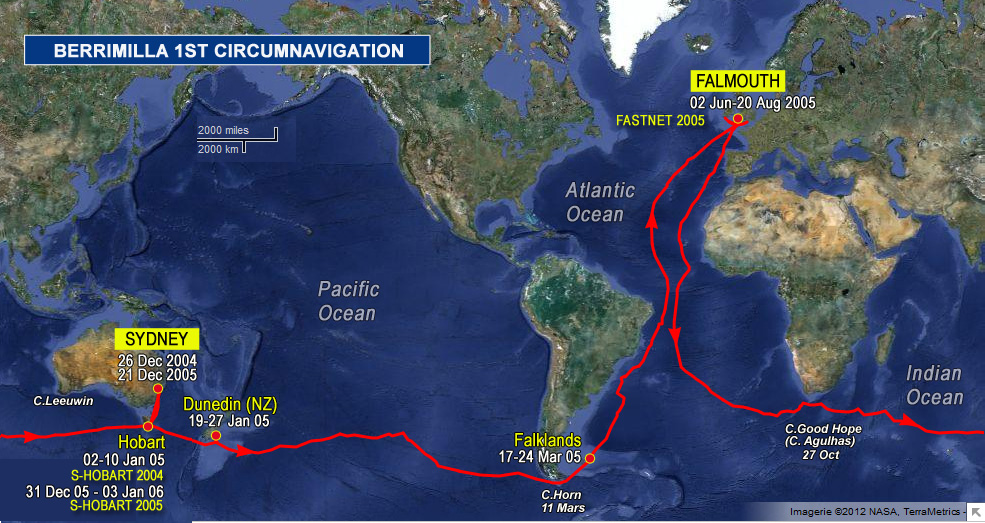0345hrs 17 Sep 2005 UTC 04’49”N 023’45”W Ref 368
Pete’s Swim: (I will add to this as we think of more)
What happened:
We are not sure how the boat came to gybe. I think that we had used the electric autopilot to tack after we put the reef in and – as often happens – the actuator arm had disconnected from the tiller so the boat was not under the control of either autopilot. It was so sudden that we assume a wave tossed the stern a long way sideways and caused the gybe.
Pete was leaning against the weather side of the boom about a metre back from the gooseneck and just got flung.
Mistakes:
1. Complacency – the preventer was not on – should be the first thing that happens – we had taken it off for one of the operations and had not re-run it. Had it been properly in place, the gybe would not have been dangerous.
2. I took my eye off the ball and went below, assuming that all was ok – as it always has been. Had I not done so, I might have seen it coming and been able to do something.
3. Pete was not tethered – as it happened, probably saved him from serious injury because he was thrown 10 – 15 feet off the boat into the water without any restriction. We both think, after analysing his trajectory, that he would have crashed into the hull if he’d been tethered. Difficult one.
4. The recovery sling with lifting tackle is (still) buried under a ton of stuff in the after locker. We will need to extract it and find more accessible stowage.
What worked:
We have talked a lot about what we would do in exactly that situation – first, the person in the boat must stop the boat as quickly as possible, then think about recovery – keep the person in the water in sight. The person in the water should swim for the turbine line faster than he’s ever swum before. Luckily, the turbine was streamed and the boat was not going fast. Once Pete had grabbed the line, the rest was easy – except for getting him back on board.
Iffy stuff:
1. There’s no way Pete had time to shout – it was so fast that he was in the water before he had time to realise he was on the way. Also, with all the ambient noise, it’s unlikely I would have been able to hear him shouting from 20 metres back in the water.
2. Having seen that Pete had the line, I didn’t even consider the rescue goodies in the cockpit – we have a throwing line that really works = we’ve tried it, and a Seattle rescue sling. I think (hope!) that if I’d actually had to consider more complex recovery action, I would have got brain into gear and used them as appropriate.
Lessons:
1. Man overboard drills in the harbour don’t give you any idea of the fear that grabs you and the time and difficulty involved in doing it for real. We should use a Seattle sling occasionally and really pick someone up under controlled conditions. (Would the sling line actually pay out and not tangle? How easy is it to deploy and what could it snag on? Could it get into the prop?) A real rescue would almost certainly involve releasing the lifelines, for instance, and making a crane with the boom or a halyard. Does the recovery tackle actually work – if it’s hard to use in the harbour, in yesterdays conditions it would have been very much harder.
2. These things do happen and out here they are potentially much more dangerous than in sight of and radio contact with help. We were lucky – it could have been much worse.
[Belmore 3!!!]
Hi again from Alex. Just waffling to give myself something to do.
A number for you – we started out with more that 2000 teabags – and I thought some of you might be interested in some of the technology in the boat – for instance, the watermaker works because water molecules (H20)are much smaller than salt molecules (NaCl) so if you force sea water through a special filter called a membrane that has holes in it just a bit bigger than water molecules, only the water goes through and the salt gets stuck on the outside. A bit like pouring sandy water through a sock – you get cloudy water through the sock but the sand gets caught inside. The watermaker uses two cycles – 2 pumps of water – and the second one is used to wash the salt back out into the sea. Might not work with my socks out here though – very cheesy – did you know that there’s a bacterium (I think) that is found in all those cheesy smelling things that makes them smell that way. I’m sure someone else reading the website knows all about this and can post it for us.
And, using the same idea as the watermaker, our waterproof breathable clothing works just like the membrane. It is made in 3 layers and, as water molecules this time are much bigger than the atoms and molecules that make up the air we breathe, (do you know what they are?) so air can get through both ways (with attendant cheese bacterium?) but water gets stuck on the outside and we stay dry and not too hot and sweaty inside. Before breathable fabric, it was horribly sweaty inside wet weather gear.
I hope all that is interesting – if not, tell us what you REALLY want to know and were afraid to ask and we’ll have a go.

 The logs ramblings can be cryptic, so we have added:
The logs ramblings can be cryptic, so we have added: